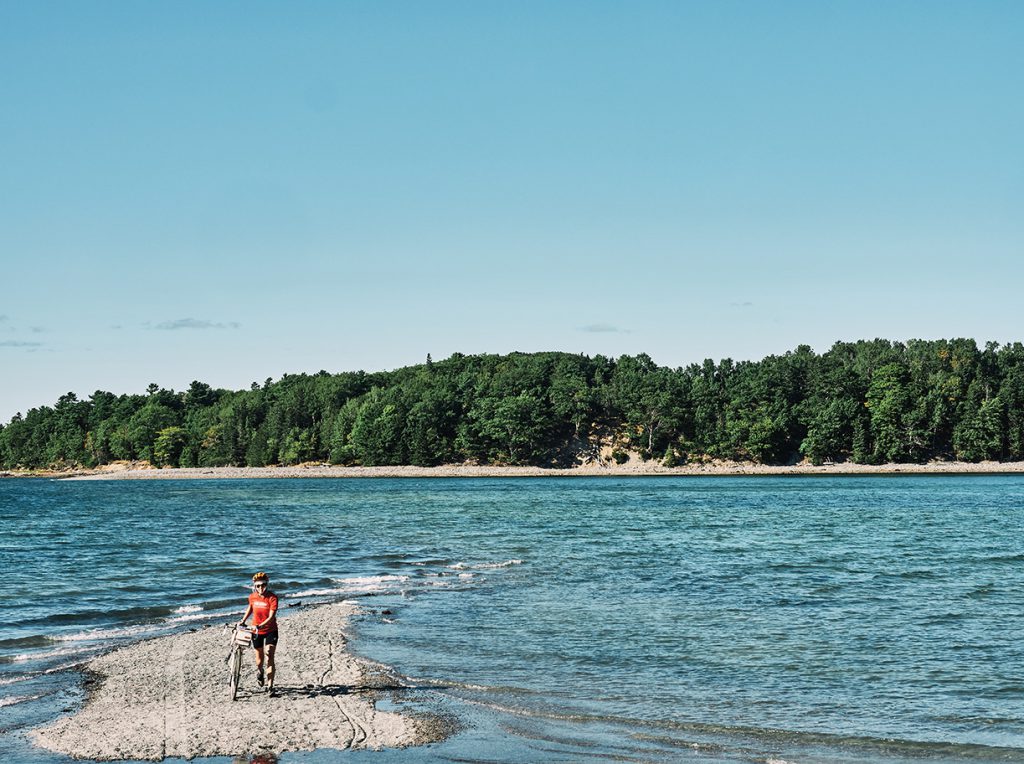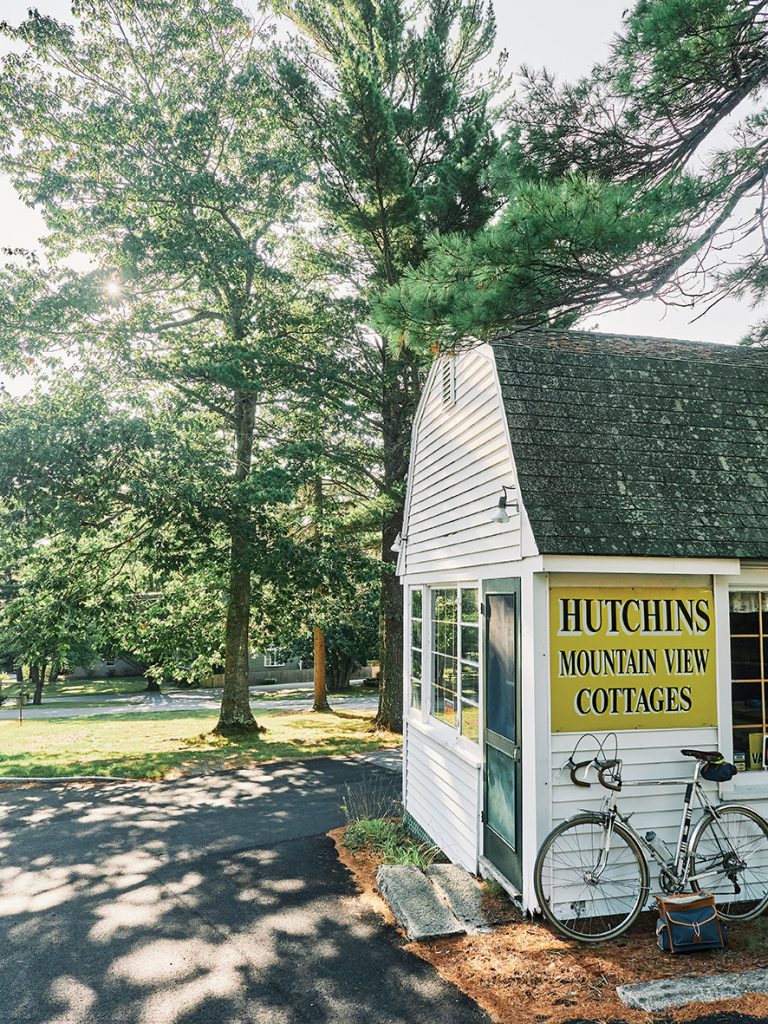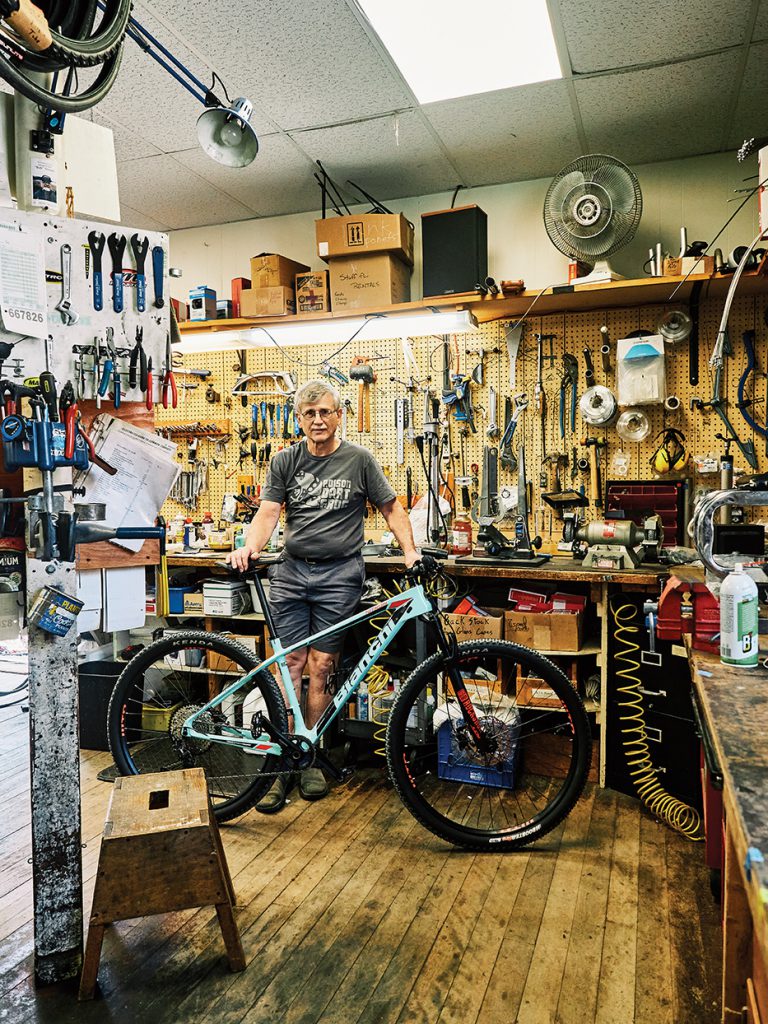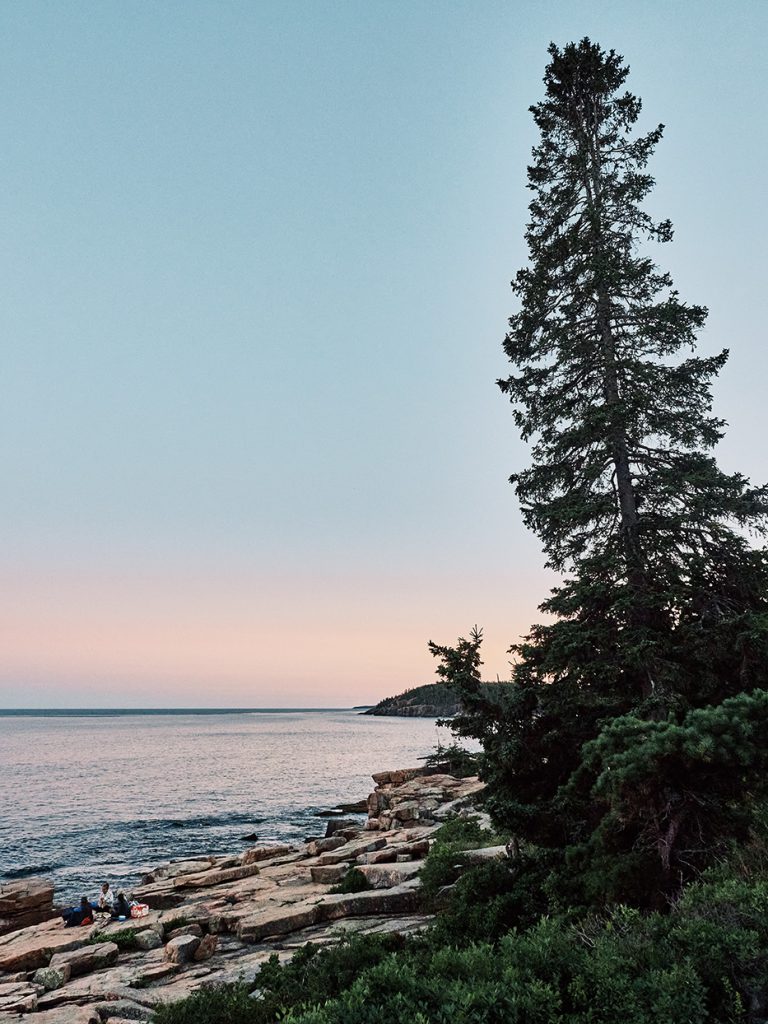Avoid the Crowds This Summer by Touring Acadia by Bike
From Bar Harbor to the carriage roads, Acadia National Park is best explored on two wheels.

Avoid the Crowds This Summer by Touring Acadia by Bike
From Bar Harbor to the carriage roads, Acadia National Park is best explored on two wheels.
Photography by Peter Frank Edwards
By Sandy Lang
Issue: August 2021
The name is Paradise. That’s the moniker of one of the first hills on this steeper-than-expected rise leading to one of the car-free carriage roads of Acadia National Park. I’d say it’s a debatable name, although the healthy throng of local cyclists who regularly pursue feats of speed and elevation on their 50- to 100-mile group rides wouldn’t blink at this uphill climb. It’s a gain of just a couple hundred feet.
Every heart-thumping incline ends in the breezy joys of a downhill ride, right? I’m counting on plenty of sweet descents on this weekend trip to Mount Desert Island, home to a network of bicycle-friendly park carriage roads in a remarkable island topography of 18 summits. That includes Cadillac Mountain, the tallest peak on North America’s shoreline at its elevation of 1,530 feet.


We picked up the Paradise Hill trail directly from a trailhead at the edge of the parking lot at the Hulls Cove entrance to the park. Like other visitors, we first navigated MDI by car, following the looping road system around the island’s eastern and western lobes. Exploring from Bar Harbor to Somes Sound to Southwest Harbor and the rest of the “quiet side” to the west, we stopped at towns and villages, trailheads and coves. These are scenic drives, but the auto traffic clogs the roadways, especially in summertime—to us, so much gasolinepowered touring doesn’t feel like the best match for immersing in this island’s natural splendor.
So, for this trip photographer Peter Frank Edwards and I aimed to tour in and around Acadia National Park in more of a fresh-air fashion. We’ve got our bicycles, and we’re ready to pedal.

Cottage Digs
To get here, we did travel by car, the bikes on a rack affixed to the tailgate. We’re booked for a couple of nights at one of the traditional lodging spots on Route 3, in the last few miles before Park Loop Road and the town of Bar Harbor—family-owned clusters and rows of tiny, neatly painted vintage cottages with flower boxes and firepits. While showing us to our lodging at Hutchins Mountain View Cottages, Sonny Gerrish explains that his father-in-law built the first three cottages in the late 1930s and added more through the decades. All face a sloping meadow, and from a picture window in our 1960s-era lodging, we see deer grazing in the distance. I’d read recommendations for this place from other cyclists who have stayed on this stretch of the island coastline and who appreciated its proximity to the park. We hop on our bikes, and within two miles we arrive at the Hulls Cove Visitor Center. We’ve already bought a park pass online, so we wind directly through the parking lot to the trail that will link us to our first carriage road ride—a loop to Witch Hole Pond and then to Duck Brook Bridge.

It’s part of the 45-mile network of car-free trails that summer resident John D. Rockefeller built between 1917 and 1940 and gifted to the park. At 16 feet wide, originally to accommodate horse-drawn carriages, the trails offer mostly smooth surfaces and passage to serene scenery in the interior. We soon stop at the edge of a small pond and watch blue jays flying between sun-bleached tree trunks and above the green rounds of lily pads. Peter Frank notices a newly shed snakeskin at the pond’s edge and holds his translucent find up to the light.
We continue onto local roads and into the village of Bar Harbor. I want to get to the actual bar, the broad sandbar that’s exposed at low tide and connects to Bar Island. But when we arrive, it’s in the final minutes before the bar is completely submerged by a high tide. I’ve got to try it. I venture out for just a few moments because the water rises so quickly that I need to push my bike across a skim of seawater to return to the beach.

Hutchins Mountain View Cottages, Mount Desert Island, Maine 
Deer with fawns, near Bass Harbor Lighthouse — Mount Desert Island, Maine
Pies To Southwest
The next morning we warm up with a brief ride along Sand Point Road and Old Bar Harbor Road on the Salisbury Cove side of Route 3, across from our lodging. Soon after, we’re also warming up to fresh-from-the-oven pie. When we saw the “Honk if you like pie” sign we decided that we needed to go get the car and drive back to buy them. A venture of two sisters descended from founders of nearby Somesville, Mount Desserts opened in 2020. Hannah Somes Babcock and Brit Babcock are baking and selling berry pies, and when we arrive we decide on a whole, still-warm strawberry rhubarb. (I have since noticed they’ve added a sour cherry variety that I’d like to try.)

After a morning of bicycling, a stop for a beachfront picnic and strawberry rhubarb pie from Mount Desserts. 
Sisters Brit Babcock and Hannah Somes Babcock at their baking company Mount Desserts, with two locations on the island.
We drive on for another park-and-pedal destination. Soon we are standing in an 1880s building with bike parts in the basement, rental bikes out back, and a fascinating balconied room upstairs. The building formerly housed the post office on Main Street in Southwest Harbor. Here we find Bob Shields among the wrenches and spoked wheels of his longtime shop, Southwest Cycle, which he opened in 1981.
“We’ve been repairing bikes that haven’t seen the light of day since Reagan was president,” Shields says, explaining that one of the pandemic’s effects has been a surge of interest in bicycling. He helps us decide on our next routes. Shields shares local knowledge, pointing to a large island map near the shop’s cash register to show us favorite carriage roads and destinations—some that are just down the backstreets in Southwest Harbor and others looping through Acadia. “It’s amazing how the park absorbs all of the people,” he says.
And he’s one of them. Each year Shields sets a goal to pedal up Cadillac Mountain as many times as his age, plus one. Most years he meets the challenge, he says. In 2021 he’s destined to spin up the mountain 68 times.

Where Cars Can’t Go
We spend the remainder of the sunny weekend exploring, adding sights and experiences we’d never have from a car: In Southwest Harbor we step along the cut-stone path of a century-old granite causeway originally created to form a natural swimming pool that fills with the high tide. From the back of Seawall Campground in Acadia we follow the Hio Truck Road, which is lined with ferns and shaded moss edges. While we are pedaling near the Wonderland Trail, the passing cars don’t notice a doe with twin fawns stepping from the woods at the roadside, but we roll to a stop to watch them for a minute or two. On the carriage road to the Amphitheater Bridge, we step off our bikes and walk under the arch to look up at the stonework from below. And when we pedal on to the Bass Harbor Head Light, we glide right past a line of cars waiting for a parking space and spin down to the bike rack on the grounds of the iconic lighthouse.

On Sunday morning we’re downtown for coffee, and we catch up with some of the dozens of cyclists gathering outside Bar Harbor Bicycle Shop, a barn-shaped store on Eden and Cottage Streets. They’ve come to the weekly meetup for a group ride. Conversations about favorite routes are a hot topic—egged on by my asking everyone on two wheels if they can share any favorites. Decked out in cycling gear and helmets, several people talk of the elevated views from the Around the Mountain Loop, accessed from the carriage roads linking to the Jordan Pond House. And about the pond and lake views on the Aunt Betty Loop. (Part of this loop, Eagle Lake Carriage Road, is undergoing construction this year, so check to see if the section is open.) And one woman suggests following the Long Pond Fire Road to catch the sunset at Pretty Marsh on the western side of the island.
The park’s pinnacle ride is along the curves of the paved roadway that winds to the top of Cadillac Mountain. As a way to celebrate his birthday, Peter Frank wants to churn up Cadillac and then coast down atop his Mercier, a vintage French bicycle that’s older than he is. He is wearing his classic wool cycling gear for the event, and his cheeks are flushed when I meet him at the bottom. He’s super-charged with adrenaline as he talks of the morning views and whooshes of sea air. “It’s been a rough year for a lot of things,” he says. “But not for bicycling, not today.”

Walking on a granite causeway in Southwest Harbor that was built in the early 20th century as a natural swimming pool, filling with each high tide. 
The Bass Harbor Head Light.
We unfold the map again to look for the next ride. (Maine-based Map Adventures makes a handy version with lots of detail.) We talk about how cycling is a terrific passport into Mount Desert Island’s web of trails in woods and alongside ponds and scenic overlooks. Being able to explore more of this mountains-meet-the sea island— the historic carriage road trails, the granite bridges and natural wonders—opens so many possibilities. Beginning, I recall, with the chance to find paradise.


Southwest Cycle, open since 1981. 
Pedaling past lobster pounds and shops.
MDI Cycling 101
Before You Go
• You’ll need a park pass and a plan. Buy your pass in advance (and see any updates about trail closures) at nps.gov/acad.
• General info about the park and its carriage roads can be find on Friends of Acadia’s website at friendsofacadia.org.
• Map Adventures sells a detailed, foldable map of Acadia that’s especially useful in sections of the park without phone signals: go to mapadventures.com.
Where to Stay
Hanscom’s Motel + Cottages | 273 Route 3, Bar Harbor | hanscomsmotel.com
Tide Watch Cabins | 560 Eden St., Bar Harbor | tidewatchcabins.com
The Claremont Hotel | 22 Claremont Road, Southwest Harbor | theclaremonthotel.com
Bass Harbor Campground | 342 Harbor Dr., Bass Harbor | bassharbor.com Hutchins Mountain View Cottages, where we stayed, is closed for the 2021 season.
Bikes, Repairs + Rentals
Southwest Cycle | 370 Main St., Southwest Harbor | southwestcycle.com
Bar Harbor Bicycle Shop | 141 Cottage St., Bar Harbor | barharborbike.com
Our Favorite Rides
Paradise Hill to Witch Hole + Duck Brook Bridge
Park at Hulls Cove Visitor Center in Bar Harbor, with options for loops on connecting trails or a there-and-back ride
Eagle Lake Loop
Park at the lots on Eagle Lake Road (Route 233), west of Bar Harbor (check for trail closures in summer 2021 before visiting)
Hio Road to Bass Harbor Light
Parking at Seawall Picnic Area or Wonderland Trail on Route 102A for a route that requires some bicycling on connecting roads
Loop to the Amphitheater Bridge
Park at Brown Mountain Gatehouse on Route 3 near Asticou Azalea Gardens
Read more travel and outdoors stories:
- Branching Out

- 48 Hours in Cape Elizabeth, South Portland + Scarborough

- 4 Unique Winter Weekends

- Brunswick in 48 Hours

Read about a bike trip from York to Lubec

